eOrganic authors:
Matthew S. Jones, Washington State University
Joseph M. Taylor, Washington State University
William E. Snyder, University of Georgia
Introduction
Ground beetle is a catch-all name given to insects in the Carabidae family of beetles of the order Coleoptera. Also known as carabids, ground beetles comprise one of the largest insect families, with approximately 40,000 species worldwide and 2,339 species in the United States (Lövei and Sunderland 1996; Kromp 1999; Bousquet 2012). They range broadly in size from 0.7-66 mm (https://bugguide.net/node/view/186). Ground beetles are known for their long legs and powerful mandibles which enable them to be voracious predators, important for the biological control of insect pests on farms (Snyder, 2019). The adult beetles hunt primarily on the soil surface, but will occasionally climb into the foliage in search of food. In addition to the adults being beneficial predators, the burrowing larvae of these beetles seek out and feed on pests in the soil. Many ground beetle species have broad feeding habits, eating not only other insects but also seeds of plants (including weeds).
Ground beetles have four distinct life stages: egg, larva, pupa, and adult. The larvae lack wings and have large pincer-like mandibles to devour other soil-dwelling organisms. For help identifying larval carabid beetles from other common insect larval types, use this guide. The egg, larval, and pupal stages are spent primarily underground while the adult life-stage is spent primarily aboveground. Adult carabid beetles have wings, but most rarely fly, and many ground beetles are completely flightless.
Pest Control Benefits of Ground Beetles
Carabids play a major role in reducing weeds and insect pests in agricultural fields. Generally, ground beetles are considered opportunistic feeders who primarily find their food in a random search, although some species hunt using sight or through the use of special hair-like appendages on their antennae (Bauer and Kredler, 1993). Many species are considered generalist predators, meaning they feed on a wide range of pests including aphids, moth larvae, beetle larvae, mites, and more. A few specialists feed on snails using specially-adapted mouthparts (Kromp, 1999).
In addition to being predators, many species are omnivorous, feeding on weed seeds as well; this is commonly referred to as seed predation. The amount of weed suppression as a result of ground beetle feeding is probably underestimated (Tooley and Brust, 2002), but weed seed predators can have a serious impact on weed management on the farm—without seed predators, weed emergence can increase up to 30% (Blubaugh and Kaplan, 2016). Additionally, many species are known to have a seasonal diet shift based on food availability, moving back and forth between insect prey and weed seeds, allowing the predators to exploit different resources throughout the year (Symondson et al., 2002; Honek et al., 2006). This allows the long-lived beetles to survive in farm environments when any single pest or weed is not available as food. In turn, this means that ground beetles are among the most tenacious generalist predators that contribute to natural pest suppression on farms. It should be noted that due to their slow reproductive rate, pesticides can cause growing-season-long reductions in their populations.
While carabids are voracious predators, certain species have been found to consume other beneficial predators, thus disrupting biological control of pests by interfering with pest suppression. This type of interruption has been seen by the common species Pterosticus melanarius, a ground beetle that was accidentally introduced to North America from Europe in ship ballast hundreds of years ago, which is known to eat other, smaller ground beetles as one of its main prey items (Lindroth, 1957).
Management
The responsiveness of carabids to farm management practices makes them a prime target for conservation biological control. Constructing areas of tall grass as a refuge for beetles has been found to increase the abundance and diversity of ground beetles (Hajek, 2018). These are often called beetle banks that can enhance the hunting activity of ground beetles in nearby farm fields by providing stable and insulated overwintering habitat, as well as alternative prey to help augment ground beetle diets while pest prey are at low abundances (MacLeod et al., 2004). While simply leaving strips of sown grass seeds to flourish can work, a more diverse mix of plants can improve function—it can take several years for the beetle bank to reach maximum benefits (Thomas, 2001). In some cases, the addition of beetle banks to farms has been shown to substantially improve biological pest control, with waves of carabids entering the field from the beetle banks (Thomas et al., 2000; Collins et al., 2002; Snyder, 2019). Living mulches, like red clover and white clover, planted between crop rows provide an ideal microclimate as well, and can attract huge numbers of ground beetles (Blubaugh et al., 2016). Lastly, nectar-producing plants will bring in airborne predators forcing some pests to flee onto the surface of the ground, where they are then available for ground beetles to devour (Losey and Denno, 1998).
In addition to managing natural habitat in and around fields, simply reducing tillage has been found to benefit ground beetle communities by lowering mortality of both seed and insect-feeding species (Shearin et al., 2014). The use of compost around plants has been shown to increase the abundance of carabids compared to bare soil, probably because the mulch maintains a cool moist climate and provides ground beetles with prey that feed on decaying plant matter (Renkema et al., 2010). While specific choices to conserve and maintain more natural flora can greatly benefit carabids, the less intensive nature of organic farming in general is also positive for ground beetles, with organic farms having higher activity and biodiversity than conventionally managed fields—particularly schemes with less intensive spraying and other chemical inputs (Tuck et al., 2014; Caro et al., 2016; Adhikari and Menalled, 2018).
How to Find Ground Beetles on Your Farm
Many ground beetles are mostly active at night and can be difficult to observe. They can occasionally be found by sifting through debris or looking under ground cover such as wood or rocks. However, the easiest way to find the ground beetles on your farm is to collect them using a pitfall trap.
Pitfall Traps
A pitfall is a basic insect trap that catches ground beetles and other active ground foragers that accidentally fall into a cup. To construct a pitfall trap, you will need:
- Post hole digger and/or trowel
- 2 cylindrical plastic containers or cups
- A trap cover (we use open-ended PVC domes, 8” diameter)
- Optional: A small amount of biodegradable dish soap and some water
If you want to release your beetles back onto your farm after trapping, simply dig a hole deep enough so that when you place the second cup into the first, the lip of the second cup is flush with the surface of the ground. Place your first cup into the hole and then slot your second cup into the first; this will be your collection cup. We recommend putting very small holes in the bottom of the first cup, to allow water to pass through in case of rain. Additionally, adding a bit of plant material at the bottom of the cup will prevent your collected beetles from eating one another. Adding a cover will prevent rainfall or irrigation water from flushing out the trap contents. Leave the trap in place overnight and pull the collection cup early in the morning to limit predation in the trap as well.
If you prefer to keep and preserve the beetles for easier identification or for a collection, you can instead fill the second container half full with water. You should also add a small amount of dish soap (2-3 drops) to break the surface tension. Because the collected beetles are killed in this version of the trap, you can leave it in place for several days to get a broader view of the beetles present.
Identification of Common West Coast Ground Beetles
While there are several groups of beneficial ground beetles, our focus is on a handful of those most commonly found in fields or gardens. For each group, we provide: a physical description of each species (body length, body color, diagnostic morphological characteristics), peak activity period (if known), habit (if known) and diet.
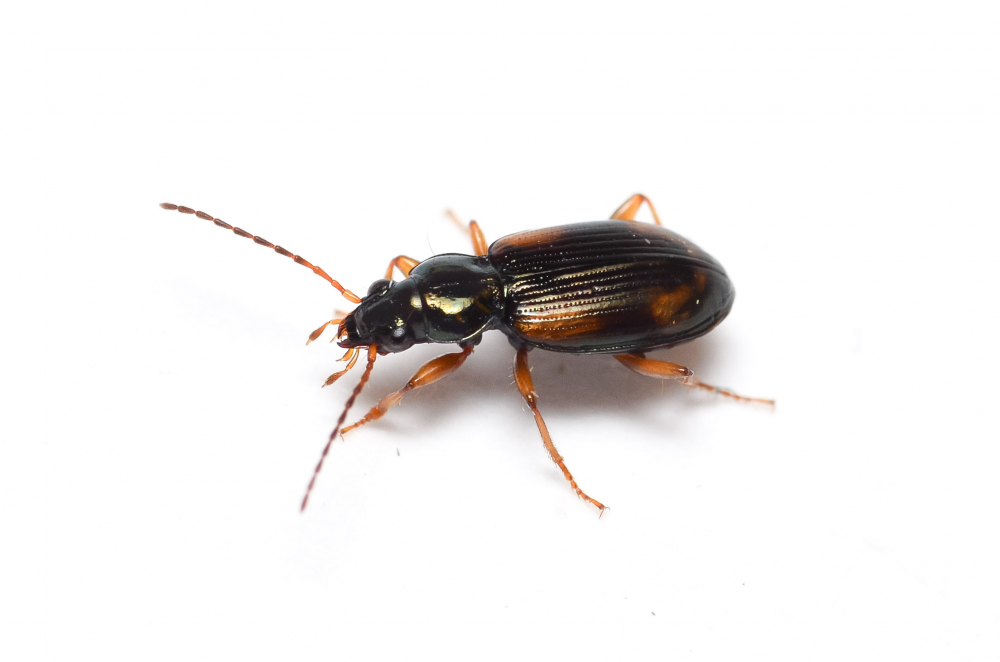
Fig. 1. Bembidion - This group is the largest genus and has several species in North America. They are fairly recognizable due to their small size (<8.5 mm) and rapid movement (Lindroth, 1969). Additionally, they are often good fliers, which is beneficial for hunting and escaping. Some species, such as B. tetracolum (shown above) have characteristic mottled brown coloration on the hard outer wing cover on their back. These ground beetles’ small size is both a benefit and a detriment in terms of biological control. Several studies have found them to be excellent predators of the small eggs and pupae of pest insects, particularly of flies. However, while these ground beetles are small enough to make good use of such tiny prey items, they are also very vulnerable to being eaten by other, larger, ground beetles, as well as other ground-dwelling predators such as spiders (Prasad and Snyder 2004, 2006). Bembidion include both day-active and nocturnal species (Luff 1978); most are water-loving. Various species of Bembidion are active throughout the summer. Photo Credit: Adam Blake (written permission granted).
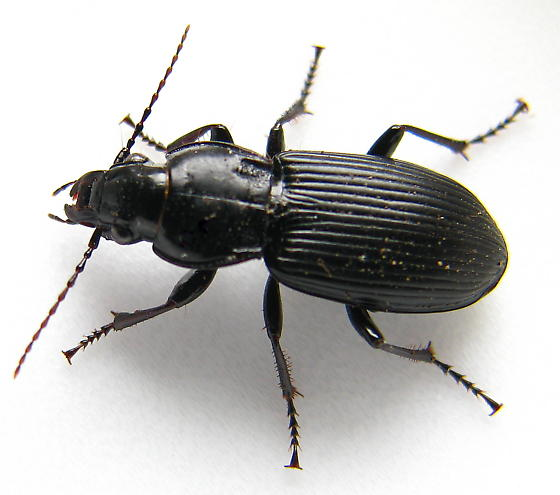
Fig 2. Pterostichus – This is one of the most common ground beetles in agricultural fields in much of North America. Chances are you have seen members of this group many times as they run across the ground in search of prey items. The group is distributed across North America and found in a wide range of habitats including grasslands, open meadows, forests, agricultural fields, in urban areas, etc. They are medium-to large sized ground beetles (~ 12-28 mm). The most common species (although invasive from Europe) in North America, P. melanarius (shown above), is a nondescript black color, but other members have more of a metallic sheen (Lindroth 1969). Many members of this group are potential biological control agents of slugs and other pests (Hance, 1990; Hatteland et al., 2010). Additionally, some studies have shown that they can climb the lower levels of plants to attack foliar pests such as aphids directly (Snyder and Ives 2001, 2003). As mentioned earlier, large Pterostichus ground beetles often feed on smaller ground beetle species which can harm natural pest control (Prasad and Snyder 2006). Pterostichus species are typically active during the night, though day active species do occur (Luff, 1978). Pterostichus species tend to emerge as adults in early summer and are active through the fall before overwintering. Photo credit: Pat Cassidy (written permission granted).
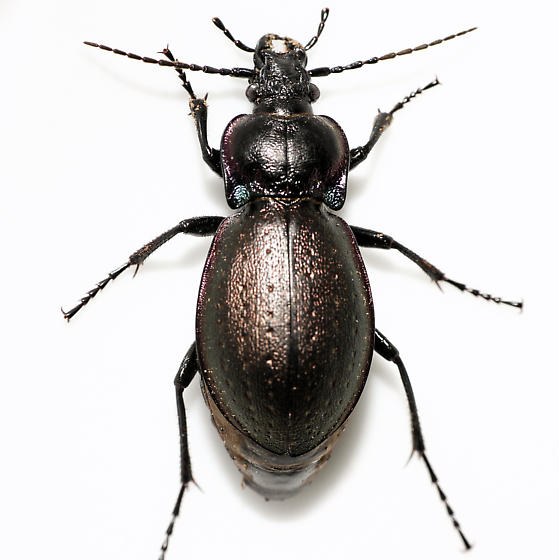
Fig. 3. Carabus - These are among the largest of ground beetles, ranging in size from 10-50 mm (Lindroth, 1969). Similar to Pterostichus, many North American species have dark coloration with some species displaying iridescent and brighter coloration. Additionally, many have distinctive dimples on their wing covers. Due to their size they have been studied as control agents of particularly large pests such as slugs and caterpillars (Hatteland et al., 2010; Hatteland et al., 2011). Because they are so large, Carabus might not directly compete with smaller ground beetles for food (Chaudhary et al., 2016). Carabus are typically active during the night (Greenslade, 1963). It should be noted that Carabus could be confused with another large genus, Calosoma. Photo credit: Fyn Kynd (written permission granted)
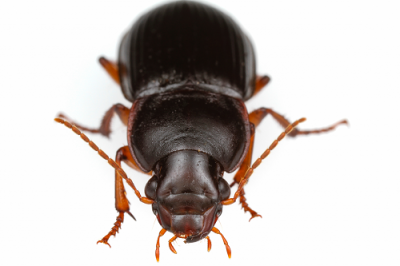
Fig 4. Harpalus - This is another large group of middle to large sized beetles (5.8-25.5 mm). While widely distributed, they mostly occur in open, dry, sandy areas. They are uniformly dark in coloration with stout bodies and short legs (Lindroth, 1969), but can also be metallic pale green and brown. They superficially resemble Pterostichus due to their coloration, but their stoutness makes them easy to tell apart when comparing the two. Furthermore, the most common species in North America, H. pensylvanicus (shown above), is reddish brown underneath which is quite distinctive (Lindroth, 1969). This group is widely distributed but mostly occur in open, dry, sandy areas. As adults they are mainly seed predators, munching away at the myriad weed seeds deposited in the soil. However, some species can make competent predators of pests, particularly in their larval stage, so this group is broadly useful (El‐Danasoury et al., 2017). Harpalus are typically active during the night (Luff, 1978). Photo credit: Salvador Vitanza (written permission granted).
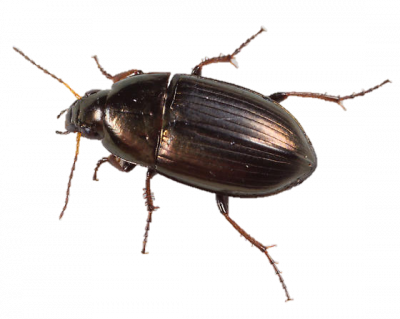
Fig 5. Amara - This group of ground beetles are generally medium sized (3.9-14.3mm) and many species have a metallic sheen. Many species in this group can be recognized by their pill shape (Lindroth, 1969). Amara have primarily been shown to be weed seed predators and have been associated with general seed rain suppression (Bohan et al., 2011). Amara as a group includes both day active and nocturnal species, and are often found in abundance on farms in early summer. Photo credit: Mardon Erbland (written permission granted).
Acknowledgements
Thanks to C. Blubaugh for pre-reviewing this manuscript. This report was funded by USDA-NIFA grant 2014-03354 and USDA-NIFA 2015-51300-24155. MSJ was supported by USDA-NIFA predoctoral fellowship 2016-04538. JMT was supported by NSF-GRFP 2016-216637.
References and Citations
- Adhikari, S., and F. D. Menalled. 2018. Impacts of dryland farm management systems on weeds and ground beetles (Carabidae) in the Northern Great Plains. Sustainability 10:2146. Available online at: https://doi.org/10.3390/su10072146 (verified 16 Mar 2023).
- Bauer, T., and M. Kredler. 1993. Morphology of the compound eyes as an indicator of life-style in carabid beetles. Canadian Journal of Zoology 71:799—810. Available online at: https://doi.org/10.1139/z93-105 (verified 16 Mar 2023).
- Blubaugh, C. K., and I. Kaplan. 2016. Invertebrate seed predators reduce weed emergence following seed rain. Weed Science 64:80—86. Available online at: https://doi.org/10.1614/WS-D-15-00111.1 (verified 16 Mar 2023).
- Blubaugh, C. K., J. R. Hagler, S. A. Machtley, and I. Kaplan. 2016. Cover crops increase foraging activity of omnivorous predators in seed patches and facilitate weed biological control. Agriculture, Ecosystems & Environment 231:264—270. Available online at: https://doi.org/10.1016/j.agee.2016.06.045 (verified 16 Mar 2023).
- Bohan, D. A., A. Boursault, D. R. Brooks, and S. Petit. 2011. National‐scale regulation of the weed seedbank by carabid predators. Journal of Applied Ecology 48:888—898. Available online at: https://doi.org/10.1111/j.1365-2664.2011.02008.x (verified 16 Mar 2023).
- Bousquet, Y. 2012. Catalogue of Geadephaga (Coleoptera, Adephaga) of America, north of Mexico. ZooKeys 245. Available online at: https://dx.doi.org/10.3897%2Fzookeys.245.3416 (verified 16 Mar 2023).
- Caro, G., R. Marrec, B. Gauffre, M. Roncoroni, S. Augiron, and V. Bretagnolle. 2016. Multi-scale effects of agri-environment schemes on carabid beetles in intensive farmland. Agriculture, Ecosystems & Environment, 229:48—56. Available online at: https://doi.org/10.1016/j.agee.2016.05.009 (verified 16 Mar 2023).
- Chaudhary, D. D., B. Kumar, and G. Mishra. 2016. Food resource exploitation in ladybirds: consequences of prey species and size. Current Science 110:1343—1349. Available online at: https://www.jstor.org/stable/24908024?seq=1 (verified 16 Mar 2023).
- Collins, K. L., N. D. Boatman, A. Wilcox, J. M. Holland, and K. Chaney. 2002. Influence of beetle banks on cereal aphid predation in winter wheat. Agriculture, Ecosystems & Environment 93:337—350. Available online at: https://doi.org/10.1016/S0167-8809(01)00340-1 (verified 16 Mar 2023).
- El‐Danasoury, H., C. Cerecedo, M. Córdoba, and J. Iglesias‐Piñeiro. 2017. Predation by the carabid beetle Harpalus rufipes on the pest slug Deroceras reticulatum in the laboratory. Annals of Applied Biology 170:251—262. Available online at: https://doi.org/10.1111/aab.12337 (verified 16 Mar 2023).
- Hajek, A. E., and J. Eilenberg, J. 2018. Natural enemies: An introduction to biological control. Cambridge University Press.
- Hance, T. 1990. Relationships between crop types, carabid phenology and aphid predation in agroecosystems. In 7th European Carabidologists' Meeting held at the Royal Entomological Society in London, London, England.
- Hatteland, B. A., W.O.C. Symondson, R. A. King, M. Skage, C. Schander, and T. Solhøy. 2011. Molecular analysis of predation by carabid beetles (Carabidae) on the invasive Iberian slug Arion lusitanicus. Bulletin of Entomological Research 101:675—686. Available online at: https://doi.org/10.1017/S0007485311000034 (verified 16 Mar 2023).
- Hatteland, B. A., K. Grutle, C. E. Mong, J. Skartveit, W.O.C. Symondson, and T. Solhøy. 2010. Predation by beetles (Carabidae, Staphylinidae) on eggs and juveniles of the Iberian slug Arion lusitanicus in the laboratory. Bulletin of Entomological Research, 100:559—567. Available online at: https://doi.org/10.1017/S0007485309990629 (verified 16 Mar 2023).
- Honek, A., P. Saska, and Z. Martinkova. 2006. Seasonal variation in seed predation by adult carabid beetles. Entomologia Experimentalis et Applicata, 118:157—162. Available online at: https://doi.org/10.1111/j.1570-7458.2006.00376.x (verified 16 Mar 2023).
- Kromp, B. 1999. Carabid beetles in sustainable agriculture: A review on pest control efficacy, cultivation impacts and enhancement. p. 187—228. In M. G. Paoletti (ed.) Invertebrate Biodiversity as Bioindicators of Sustainable Landscapes. Elsevier Science.
- Lindroth, C. H. 1957. The faunal connections between Europe and North America (No. QL512 L5).
- Lindroth, C. H. 1961. The ground beetles (Carabidae, excl. Cicindelinae) of Canada and Alaska, Part 2-6. Opuscula Entomologica, (Suppl.), 1-1192.
- Losey, J. E., and R. F. Denno. 1998. The escape response of pea aphids to foliar‐foraging predators: Factors affecting dropping behaviour. Ecological Entomology 23:53—61. Available online at: https://doi.org/10.1046/j.1365-2311.1998.00102.x (verified 16 Mar 2023).
- Lövei, G. L., and K. D. Sunderland. 1996. Ecology and behavior of ground beetles (Coleoptera: Carabidae). Annual Review of Entomology, 41:231—256. Available online at: https://doi.org/10.1146/annurev.en.41.010196.001311 (verified 16 Mar 2023).
- Luff, M. L. 1978. Diel activity patterns of some field Carabidae. Ecological Entomology, 3:53—62. Available online at: https://doi.org/10.1111/j.1365-2311.1978.tb00902.x (verified 16 Mar 2023).
- MacLeod, A., S. D. Wratten, N. W. Sotherton, and M. B. Thomas. 2004. ‘Beetle banks’ as refuges for beneficial arthropods in farmland: Long‐term changes in predator communities and habitat. Agricultural and Forest Entomology 6:147—154. Available online at: https://doi.org/10.1111/j.1461-9563.2004.00215.x (verified 16 Mar 2023).
- Prasad, R. P., and W. E. Snyder. 2004. Predator interference limits fly egg biological control by a guild of ground-active beetles. Biological Control 31:428—437. Available online at: https://doi.org/10.1016/j.biocontrol.2004.07.005 (verified 16 Mar 2023).
- Prasad, R. P., and W. E. Snyder. 2006. Polyphagy complicates conservation biological control that targets generalist predators. Journal of Applied Ecology, 43:343—352. Available online at: https://doi.org/10.1111/j.1365-2664.2006.01129.x (verified 16 Mar 2023).
- Renkema, J. M., S. J. Walde, D. H. Lynch, G. C. Cutler, and K. MacKenzie. 2010. Ground beetles (Carabidae) are affected by mulch in organic highbush blueberries. Acta Horticulturae 933:447—453. Available online at: https://doi.org/10.17660/ActaHortic.2012.933.58 (verified 16 Mar 2023).
- Shearin, A. F., S. C. Reberg-Horton, and E. R. Gallandt. 2014. Direct effects of tillage on the activity density of ground beetle (Coleoptera: Carabidae) weed seed predators. Environmental Entomology 36:1140-1146. Available online at: https://doi.org/10.1603/0046-225X(2007)36[1140:DEOTOT]2.0.CO;2 (verified 16 Mar 2023).
- Snyder, W. E. 2019. Give predators a complement: conserving natural enemy biodiversity to improve biocontrol. Biological Control 135:73&mdash:82. Available online at: https://doi.org/10.1016/j.biocontrol.2019.04.017 (verified 16 Mar 2023).
- Snyder, W. E., and A. R. Ives. 2001. Generalist predators disrupt biological control by a specialist parasitoid. Ecology 82:705—716. Available online at: https://doi.org/10.1890/0012-9658(2001)082[0705:GPDBCB]2.0.CO;2 (verified 16 Mar 2023).
- Snyder, W. E., and A. R. Ives. 2003. Interactions between specialist and generalist natural enemies: parasitoids, predators, and pea aphid biocontrol. Ecology 84:91—107. Available online at: https://doi.org/10.1890/0012-9658(2003)084[0091:IBSAGN]2.0.CO;2 (verified 16 Mar 2023).
- Symondson, W. O. C., K. D. Sunderland, and M. H. Greenstone. 2002. Can generalist predators be effective biocontrol agents? Annual Review of Entomology, 47:561—594. Available online at: https://doi.org/10.1146/annurev.ento.47.091201.145240 (verified 16 Mar 2023).
- Tooley, J. A., G. E. Brust. 2002. Weed seed predation by carabid beetles. p. 215—230. In Holland, J. M. (ed.) The Agroecology of Carabid Beetles. Andover UK Intercept Ltd.
- Thomas, S. R. 2001. Assessing the value of beetle banks for enhancing farmland biodiversity. Doctoral thesis. University of Southampton, Southampton, England. Available online at: https://eprints.soton.ac.uk/426725/ (verified 16 Mar 2023).
- Thomas, S., D. Goulson, and J. Holland. 2000. Spatial and temporal distributions of predatory Carabidae in a winter wheat field. Aspects of Applied Biology 62:55—60.
- Tuck, S. L., C. Winqvist, F. Mota, J. Ahnström, L. A. Turnbull, and J. Bengtsson. 2014. Land‐use intensity and the effects of organic farming on biodiversity: A hierarchical meta‐analysis. Journal of Applied Ecology 51:746—755. Available online at: https://doi.org/10.1111/1365-2664.12219(verified 16 Mar 2023).



